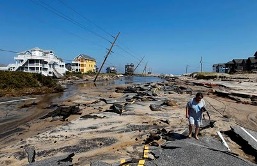 US National Guard helicopters began taking food and water today to towns cut off by flooding after the rainy remnants of Hurricane Irene took inland areas of New England and upstate New York by surprise.
US National Guard helicopters began taking food and water today to towns cut off by flooding after the rainy remnants of Hurricane Irene took inland areas of New England and upstate New York by surprise.
Emergency Management spokesman Mark Bosma said the helicopters would bring relief to people in about a dozen towns where roads and bridges were washed out, including Cavendish, Hancock, Pittsfield, Stockbridge, Strafford and Stratton.
Officials also used heavy-duty National Guard vehicles to reach towns where roads may be passable.
In a deluge that caught many communities off guard, Irene dumped up to 28cms of rain in some places in Vermont, turning placid mountain streams into roaring brown torrents that smashed buildings and ripped homes from their foundations. At least three people died in Vermont.
Small towns in upstate New York, especially in the Catskills and the Adirondacks, were also besieged by floodwaters.
At least 46 people were reported killed by the storm, which blew through the Caribbean and up the US eastern seaboard before hitting Canada.
In the small Vermont town of Newfane, about 150 people were unable to drive cars to their homes, 30 of them effectively stranded in theirs. Seven bridges were washed out. Two homes were knocked from their foundations by surging floodwaters. One 19th-century grist mill was smashed into kindling wood.
“I need a shower,” said Sue Saylor. “I need water. I need electricity. It’s rough.”
Vermont emergency officials and the US National Weather Service had warned before the storm about the potential for heavy rain and flooding. The governor urged people to prepare for heavy rain, high winds and possible lengthy power outages and recommended stocking up on food, water and other supplies.
Transportation was getting back to normal in most eastern US states today, though some towns still grappled with flooding and many homes and businesses remained without electricity.
In New York City, where people had braced for a disaster-movie scene of water swirling around skyscrapers, the subways and buses were up and running again in time for the morning commute yesterday.
By today, a majority of riders on the hard-hit commuter rail lines in New York were able to get onto trains to the centre of the city, although some nearby Long Island communities still were without service because of flooded tracks.
Some Amtrak rail service in the Northeast was limited or suspended, and airlines said it would be days before the thousands of passengers stranded by Irene find their way home.
The death toll for 12 eastern US states rose to at least 40 as bodies were pulled from floodwaters and people were struck by falling trees or electrocuted by downed power lines.
A driver was missing after a road collapsed and swallowed two cars about 100 kilometres northeast of Montreal.
Irene also killed at least five people in the Dominican Republic and Haiti and a woman in the US territory of Puerto Rico.
For many people, the aftermath could prove more painful than the storm itself.
In North Carolina, where Irene blew ashore along the Outer Banks on Sunday before heading to the north, some 1000 people were still in emergency shelters, awaiting word on their homes.
Utilities along the Eastern Seaboard reported today that about three million customers remained in the dark, down from a peak of more than eight million.
Thousands of repair crews were still combing through a tangle of uprooted trees and floodwaters in 13 states.
Early estimates put Irene’s damage at $US7 billion ($6.57 billion) to $US10 billion, much smaller than the impact of monster storms such as Hurricane Katrina, which did more than $US100 billion in damage. Irene’s effects are small compared to the overall US economy, which produces about $US14 trillion of goods and services every year.


